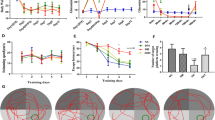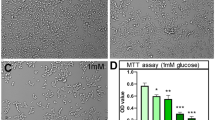Abstract
Type 1 and type 2 diabetic patients who are treated with insulin or other blood glucose reducing agents for tight control of blood glucose levels are frequently at risk of experiencing severe hypoglycemia which can lead to seizures, loss of consciousness and death. Hypoglycemic neuronal cell death is not a simple result of low glucose supply to the brain, but, instead, results from a cell death signaling pathway that is started by the re-administration of glucose after glucose deprivation. Zinc is a biologically important element for physiological function of central nervous system. However, excessive zinc release from the presynaptic terminals and subsequent translocation into the postsynaptic neurons may contribute to neuronal death following hypoglycemia. N-acetyl-l-cysteine (NAC) acts as a zinc chelator that alleviates zinc-induced neuronal death processes. In addition, NAC restores levels of neuronal glutathione (GSH), a potent antioxidant, by providing a cell-permeable source of cysteine. Thus, we hypothesized that NAC treatment can reduce neuronal cell death, not only by increasing GSH concentration but also by zinc chelation. As a result, we found that NAC decreased the oxidative stress, zinc release and translocation, and improved the level of glutathione. Therefore, NAC administration alleviated hippocampal neuron death in hypoglycemia-induced rats.






Similar content being viewed by others
References
Agardh CD, Folbergrova J, Siesjo BK (1978) Cerebral metabolic changes in profound, insulin-induced hypoglycemia, and in the recovery period following glucose administration. J Neurochem 31(5):1135–1142
Agardh CD, Kalimo H, Olsson Y, Siesjo BK (1980) Hypoglycemic brain injury. I. Metabolic and light microscopic findings in rat cerebral cortex during profound insulin-induced hypoglycemia and in the recovery period following glucose administration. Acta Neuropathol 50(1):31–41
Alvarez A, Cacabelos R, Sanpedro C, Garcia-Fantini M, Aleixandre M (2007) Serum TNF-alpha levels are increased and correlate negatively with free IGF-I in Alzheimer disease. Neurobiol Aging 28(4):533–536. doi:10.1016/j.neurobiolaging.2006.02.012
Aoyama K, Watabe M, Nakaki T (2008) Regulation of neuronal glutathione synthesis. J Pharmacol Sci 108(3):227–238
Arakawa M, Ito Y (2007) N-acetylcysteine and neurodegenerative diseases: basic and clinical pharmacology. Cerebellum 6(4):308–314. doi:10.1080/14734220601142878
Auer RN, Siesjo BK (1993) Hypoglycaemia: brain neurochemistry and neuropathology. Baillieres Clin Endocrinol Metab 7(3):611–625
Auer RN, Olsson Y, Siesjo BK (1984) Hypoglycemic brain injury in the rat. Correlation of density of brain damage with the EEG isoelectric time: a quantitative study. Diabetes 33(11):1090–1098
Auer RN, Hall P, Ingvar M, Siesjo BK (1986) Hypotension as a complication of hypoglycemia leads to enhanced energy failure but no increase in neuronal necrosis. Stroke 17(3):442–449
Berk M, Malhi GS, Gray LJ, Dean OM (2013) The promise of N-acetylcysteine in neuropsychiatry. Trends Pharmacol Sci 34(3):167–177. doi:10.1016/j.tips.2013.01.001
Britschgi M, Wyss-Coray T (2007) Systemic and acquired immune responses in Alzheimer’s disease. Int Rev Neurobiol 82:205–233. doi:10.1016/S0074-7742(07)82011-3
Coyle JT, Puttfarcken P (1993) Oxidative stress, glutamate, and neurodegenerative disorders. Science 262(5134):689–695
Fatourechi MM, Kudva YC, Murad MH, Elamin MB, Tabini CC, Montori VM (2009) Clinical review: hypoglycemia with intensive insulin therapy: a systematic review and meta-analyses of randomized trials of continuous subcutaneous insulin infusion versus multiple daily injections. J Clin Endocrinol Metab 94(3):729–740. doi:10.1210/jc.2008-1415
Ferrand-Drake M, Zhu C, Gido G, Hansen AJ, Karlsson JO, Bahr BA, Zamzami N, Kroemer G, Chan PH, Wieloch T, Blomgren K (2003) Cyclosporin A prevents calpain activation despite increased intracellular calcium concentrations, as well as translocation of apoptosis-inducing factor, cytochrome c and caspase-3 activation in neurons exposed to transient hypoglycemia. J Neurochem 85(6):1431–1442
Fink MP (2008) Ethyl pyruvate. Curr Opin Anaesthesiol 21(2):160–167. doi:10.1097/ACO.0b013e3282f63c2e
Fioramonti X, Song Z, Vazirani RP, Beuve A, Routh VH (2011) Hypothalamic nitric oxide in hypoglycemia detection and counterregulation: a two-edged sword. Antioxid Redox Signal 14(3):505–517. doi:10.1089/ars.2010.3331
Frederickson CJ (1989) Neurobiology of zinc and zinc-containing neurons. Int Rev Neurobiol 31:145–238
Frederickson CJ, Moncrieff DW (1994) Zinc-containing neurons. Biol Signals 3(3):127–139
Frederickson CJ, Kasarskis EJ, Ringo D, Frederickson RE (1987) A quinoline fluorescence method for visualizing and assaying the histochemically reactive zinc (bouton zinc) in the brain. J Neurosci Methods 20(2):91–103
Frederickson CJ, Hernandez MD, Goik SA, Morton JD, McGinty JF (1988) Loss of zinc staining from hippocampal mossy fibers during kainic acid induced seizures: a histofluorescence study. Brain Res 446(2):383–386
Holmay MJ, Terpstra M, Coles LD, Mishra U, Ahlskog M, Oz G, Cloyd JC, Tuite PJ (2013) N-Acetylcysteine boosts brain and blood glutathione in Gaucher and Parkinson diseases. Clin Neuropharmacol 36(4):103–106. doi:10.1097/WNF.0b013e31829ae713
Howell GA, Welch MG, Frederickson CJ (1984) Stimulation-induced uptake and release of zinc in hippocampal slices. Nature 308(5961):736–738
Hsu SM, Raine L, Fanger H (1981) Use of avidin-biotin-peroxidase complex (ABC) in immunoperoxidase techniques: a comparison between ABC and unlabeled antibody (PAP) procedures. J Histochem Cytochem 29(4):577–580
Janssen MM, Snoek FJ, de Jongh RT, Casteleijn S, Deville W, Heine RJ (2000) Biological and behavioural determinants of the frequency of mild, biochemical hypoglycaemia in patients with Type 1 diabetes on multiple insulin injection therapy. Diabetes Metab Res Rev 16(3):157–163
Karalija A, Novikova LN, Kingham PJ, Wiberg M, Novikov LN (2012) Neuroprotective effects of N-acetyl-cysteine and acetyl-l-carnitine after spinal cord injury in adult rats. PLoS ONE 7(7):e41086. doi:10.1371/journal.pone.0041086
Kauppinen TM, Swanson RA (2005) Poly(ADP-ribose) polymerase-1 promotes microglial activation, proliferation, and matrix metalloproteinase-9-mediated neuron death. J Immunol 174(4):2288–2296
Kauppinen TM, Higashi Y, Suh SW, Escartin C, Nagasawa K, Swanson RA (2008) Zinc triggers microglial activation. J Neurosci 28(22):5827–5835. doi:10.1523/JNEUROSCI.1236-08.2008
Kim SU, de Vellis J (2005) Microglia in health and disease. J Neurosci Res 81(3):302–313. doi:10.1002/jnr.20562
Lewis LD, Ljunggren B, Ratcheson RA, Siesjo BK (1974) Cerebral energy state in insulin-induced hypoglycemia, related to blood glucose and to EEG. J Neurochem 23(4):673–679
Liu W, Wang X, Yang S, Huang J, Xue X, Zheng Y, Shang G, Tao J, Chen L (2016) Electroacupunctre improves motor impairment via inhibition of microglia-mediated neuroinflammation in the sensorimotor cortex after ischemic stroke. Life Sci 151:313–322. doi:10.1016/j.lfs.2016.01.045
McCoy RG, Lipska KJ, Yao X, Ross JS, Montori VM, Shah ND (2016) Intensive treatment and severe hypoglycemia among adults with type 2 diabetes. JAMA Intern Med. doi:10.1001/jamainternmed.2016.2275
McCrimmon RJ, Sherwin RS (2010) Hypoglycemia in type 1 diabetes. Diabetes 59(10):2333–2339. doi:10.2337/db10-0103
Nehru B, Kanwar SS (2004) N-acetylcysteine exposure on lead-induced lipid peroxidative damage and oxidative defense system in brain regions of rats. Biol Trace Elem Res 101(3):257–264. doi:10.1385/BTER:101:3:257
Nellgard B, Wieloch T (1992) Cerebral protection by AMPA- and NMDA-receptor antagonists administered after severe insulin-induced hypoglycemia. Exp Brain Res 92(2):259–266
Noh KM, Koh JY (2000) Induction and activation by zinc of NADPH oxidase in cultured cortical neurons and astrocytes. J Neurosci 20(23):RC111
Rushworth GF, Megson IL (2014) Existing and potential therapeutic uses for N-acetylcysteine: the need for conversion to intracellular glutathione for antioxidant benefits. Pharmacol Ther 141(2):150–159. doi:10.1016/j.pharmthera.2013.09.006
Russell JW, Sullivan KA, Windebank AJ, Herrmann DN, Feldman EL (1999) Neurons undergo apoptosis in animal and cell culture models of diabetes. Neurobiol Dis 6(5):347–363. doi:10.1006/nbdi.1999.0254
Ruth RE, Feinerman GS (1988) Foreign and endogenous serum protein extravasation during harmaline tremors or kainic acid seizures in the rat: a comparison. Acta Neuropathol 76(4):380–387
Safonova OA, Popova TN, Kryl’skii DV (2016) Glutathione system activity in rat tissues under phenylethyl biguanide action on the background of experimental brain ischemia/reperfusion development. Eksp Klin Farmakol 79(1):23–27
Schafer FQ, Buettner GR (2001) Redox environment of the cell as viewed through the redox state of the glutathione disulfide/glutathione couple. Free Radic Biol Med 30(11):1191–1212
Schmued LC, Hopkins KJ (2000) Fluoro-Jade B: a high affinity fluorescent marker for the localization of neuronal degeneration. Brain Res 874(2):123–130
Sheline CT, Behrens MM, Choi DW (2000) Zinc-induced cortical neuronal death: contribution of energy failure attributable to loss of NAD(+) and inhibition of glycolysis. J Neurosci 20(9):3139–3146
Singh P, Jain A, Kaur G (2004) Impact of hypoglycemia and diabetes on CNS: correlation of mitochondrial oxidative stress with DNA damage. Mol Cell Biochem 260(1–2):153–159
Suh SW, Thompson RB, Frederickson CJ (2001) Loss of vesicular zinc and appearance of perikaryal zinc after seizures induced by pilocarpine. NeuroReport 12(7):1523–1525
Suh SW, Aoyama K, Chen Y, Garnier P, Matsumori Y, Gum E, Liu J, Swanson RA (2003) Hypoglycemic neuronal death and cognitive impairment are prevented by poly(ADP-ribose) polymerase inhibitors administered after hypoglycemia. J Neurosci 23(33):10681–10690
Suh SW, Garnier P, Aoyama K, Chen Y, Swanson RA (2004) Zinc release contributes to hypoglycemia-induced neuronal death. Neurobiol Dis 16(3):538–545. doi:10.1016/j.nbd.2004.04.017
Suh SW, Gum ET, Hamby AM, Chan PH, Swanson RA (2007) Hypoglycemic neuronal death is triggered by glucose reperfusion and activation of neuronal NADPH oxidase. J Clin Invest 117(4):910–918. doi:10.1172/JCI30077
Suh SW, Hamby AM, Gum ET, Shin BS, Won SJ, Sheline CT, Chan PH, Swanson RA (2008) Sequential release of nitric oxide, zinc, and superoxide in hypoglycemic neuronal death. J Cereb Blood Flow Metab 28(10):1697–1706. doi:10.1038/jcbfm.2008.61
Sunitha K, Hemshekhar M, Thushara RM, Santhosh MS, Yariswamy M, Kemparaju K, Girish KS (2013) N-Acetylcysteine amide: a derivative to fulfill the promises of N-acetylcysteine. Free Radic Res 47(5):357–367. doi:10.3109/10715762.2013.781595
Tallroth G, Lindgren M, Stenberg G, Rosen I, Agardh CD (1990) Neurophysiological changes during insulin-induced hypoglycaemia and in the recovery period following glucose infusion in type 1 (insulin-dependent) diabetes mellitus and in normal man. Diabetologia 33(5):319–323
Tanenberg RJ, Newton CA, Drake AJ (2010) Confirmation of hypoglycemia in the “dead-in-bed” syndrome, as captured by a retrospective continuous glucose monitoring system. Endocr Pract 16(2):244–248. doi:10.4158/EP09260.CR
Acknowledgements
We would like express our special thanks to Dr. Hui Chul Choi (Neurology, Hallym University, College of Medicine, Chuncheon, Korea) for valuable discussions. This work was also supported by Brain Research Program through the National Research Foundation of Korea (NRF) funded by the Ministry of Science, ICT and Future Planning (NRF-2016M3C7A1913844) to S.W.S.
Author information
Authors and Affiliations
Corresponding author
Ethics declarations
Conflict of interest
The authors declare no conflict of interest.
Research involving animals
All procedures performed in studies involving animals were in accordance with the ethical standards of the Institutional Animal Studies Care and Use Committee of the Hallym University in Chuncheon, Korea (Protocol # Hallym-2015-50).
Additional information
Handling Editor: H. S. Sharma.
Rights and permissions
About this article
Cite this article
Kho, A.R., Choi, B.Y., Kim, J.H. et al. Prevention of hypoglycemia-induced hippocampal neuronal death by N-acetyl-l-cysteine (NAC). Amino Acids 49, 367–378 (2017). https://doi.org/10.1007/s00726-016-2370-5
Received:
Accepted:
Published:
Issue Date:
DOI: https://doi.org/10.1007/s00726-016-2370-5




